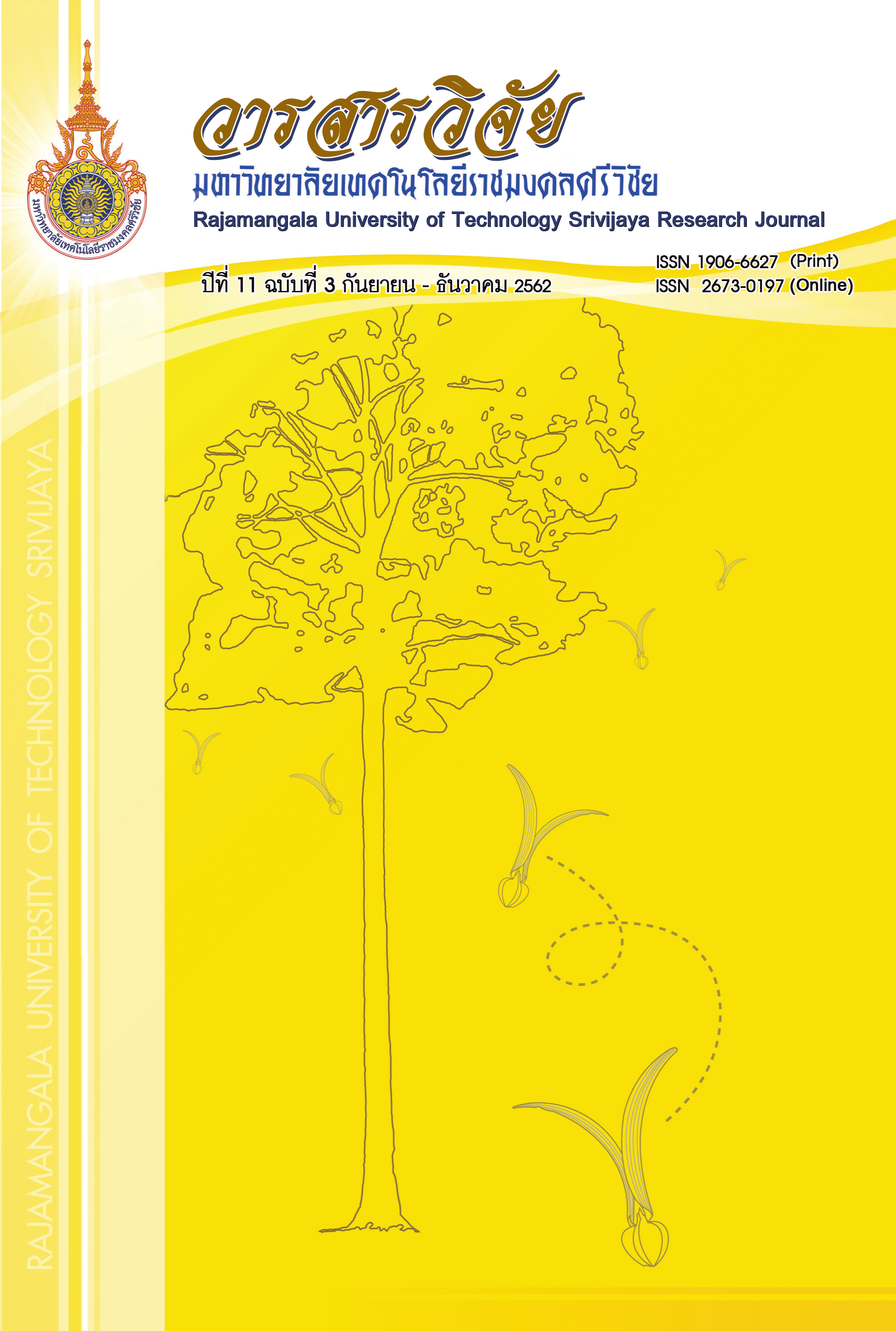The Uses of Broken Riceberry and Moringa Leaf Meal in Semi-Free-Range Layer Diets
Keywords:
semi-free-range layer, Riceberry broken rice, moringa leaf mealAbstract
The aim of this research was to study the effect of using Riceberry broken rice and moringa leaf meal in semi-free-range layer diets. 2 × 2 Factorial in completely randomized block design was used in this experiment. Factor A was Semi-free-range Housing Model (sunshine and shade). Factor B was experimental diets (Diet 1: control diet that used Riceberry broken rice as energy source without adding moringa leaf meal, Diet 2: control diet that used Riceberry broken rice as energy source mixed with 6 % of moringa leaf meal). One hundred eighty-four laying hens (Isa Brown breed, 40 weeks of age) were divided into 4 groups in each house (23 birds of each group). The laying hens in each house were randomly assigned to 4 combination treatments. There were 2 periods (28 days per period) to collect data of egg production and egg quality. In the last period, the feces of each group were randomly collected to determine the number of microorganism (total plate count, coliform, salmonella and lactic acid bacteria); in addition, egg of each group were randomly collected for cholesterol and β-carotene analysis. The results showed that egg production percentage, feed conversion ratio per 1 kilogram of egg weight, and feed cost per 1 kilogram of egg weight of the laying hens fed with Diet 2 were poorer than Diet 1. However, there were no statistical difference between 2 diet groups of daily feed intakes. In addition, there were no statistical difference among 2 groups of 2 factors on egg quality (egg weight, albumen height, Haugh unit, eggshell thickness and cholesterol) and the number of total plate count, coliform salmonella and lactic acid bacteria in feces (p>0.05). However, the color of the egg yolk and β-carotene in egg yolk of the group that fed with Diet 2 was higher than Diet 1 (p<0.01 and p <0.05, respectively). Besides, productive performance of layers reared in shade house were higher than sunshine house. However, there were no influence of housing model on the number of microorganisms in feces and egg quality.
References
จินตนา อินทรมงคล. 2553. การเลี้ยงไก่ไข่อินทรีย์แบบปล่อย. เอกสารเผยแพร่, ศูนย์ปศุสัตว์อินทรีย์ กรมปศุสัตว์.
ชื่นจิต สีพญา. 2558. ไรซ์เบอร์รี่ ข้าวดีมีประโยชน์. แหล่งที่มา: http://www.sininrice.com/insight.html, 26 กรกฎาคม 2560.
ณิฐิมา เฉลิมแสน, บุญชู นาวานุเคราะห์, ธัญรัตน์ จารี, สมเพชร สุริยวงษ์, สุชาดา พูลเกตุ และ สุธามาศ ผลมา. 2557. การประเมินคุณค่าทางโภชนะของใบมะรุมเพื่อใช้เป็นวัตถุดิบอาหารสำหรับไก่กระทง. วารสารวิชาการและวิจัย มทร.พระนคร (ฉบับพิเศษ): 42-47.
ณิฐิมา เฉลิมแสน, บุญชู นาวานุเคราะห์, อรรถพล ตันไสว และ ธัญรัตน์ จารี. 2558. การใช้ใบมะรุมในอาหารไก่ไข่, น. 275-282. ใน รายงานการประชุมวิชาการระดับชาติ มหาวิทยาลัยเทคโนโลยีราชมงคล ครั้งที่ 6 (สาขาวิทยาศาสตร์และเทคโนโลยี และสาขาเกษตรศาสตร์ และอุตสาหกรรมอาหาร). มหาวิทยาลัยเทคโนโลยีราชมงคลสุวรรณภูมิ ศูนย์หันตรา, พระนครศรีอยุธยา.
ณิฐิมา เฉลิมแสน, บุญชู นาวานุเคราะห์, จุฑารักษ์ กิติยานุภาพ, สมยศ หมื่นวัง และ สุชาติ มันตาธรรม. 2559. การใช้ใบมะรุมในอาหารนกกระทาไข่. วารสารวิจัยมหาวิทยาลัยเทคโนโลยีราชมงคลศรีวิชัย 8(2): 137-146.
ณิฐิมา เฉลิมแสน, สมศรี ขจิตเพชรจรัส, กรณิศ ขจิตเพชรจรัส และ ธัญรัตน์ จารี. 2560. การใช้ปลายข้าวไรซ์เบอร์รี่ร่วมกับใบมะรุมในอาหารนกกระทาไข่. วารสารวิทยาศาสตร์เกษตร 4(2) ฉบับพิเศษ: 128-129.
นิดดา หงษ์วิวัฒน์, ทวีทอง หงส์วิวัฒน์ และ สุภาพรรณ เยี่ยมชัยภูมิ. 2548. ผัก 333 ชนิดคุณค่าอาหารและการกิน. บริษัทสำนักพิมพ์แสงแดด จำกัด, กรุงเทพฯ.
พนิสนันท์ เล็กมาก, กนกพร อยู่สถาน, วิริยวิชญ์ ทรัพย์ประเสริฐ และ สารวย มะลิถอด. 2559. การเสริมใบมะรุมผงเพื่อลดต้นทุนการผลิตและเพิ่มคุณภาพไข่ของไก่อายุ 40-52 สัปดาห์, น. 405-410. ใน รายงานการประชุมวิชาการงานเกษตรนเรศวร ครั้งที่ 14. มหาวิทยาลัยนเรศวร, พิษณุโลก.
ภุชงค์ วีรดิษฐกิจ. 2557. อิทธิพลของการเสริมใบมะรุมในอาหารต่อการผลิตไข่ คุณภาพไข่คลอเลสเตอรอลในไข่แดงและในเลือด และผลทางโลหิตวิทยาในไก่ไข่. วิทยานิพนธ์ปริญญาวิทยาศาสตรมหาบัณฑิต, มหาวิทยาลัยธรรมศาสตร์.
ภุชงค์ วีรดิษฐกิจ และ ไพโชค ปัญจะ. 2558. อิทธิพลของการเสริมใบมะรุมผงในอาหารไก่ไข่ ต่อสมรรถภาพการผลิตและคุณภาพไข่. วารสารวิทยาศาสตร์และเทคโนโลยี 23(2): 293-305.
รัฐศักดิ์ พลสิงห์. 2552. มะรุม พืชมหรรศจรรย์ สมุนไพรครอบจักรวาล. วารสารกสิกร 82(2): 61-68.
วรยุทธ ยอดบุญ, ประเวทย์ ตุ้ยเต็มวงศ์ และ ฆรณี ตุ้ยเต็มวงศ์. 2555. รายงานการวิจัย ผลของสารสกัดจากพืชสมุนไพร ที่มีคุณสมบัติในการยับยั้งการเจริญของเชื้อจุลินทรีย์. คณะวิทยาศาสตร์, มหาวิทยาลัยเกษตรศาสตร์.
สุธาทิพย์ ภมรประวัติ. 2550. มะรุม ลดไขมันป้องกันมะเร็ง. แหล่งข้อมูล: http://www.doctor.or.th/node/1245, 2 กรกฎาคม 2553.
Abou-Elezz, F.M.K., Sarmiento-Franco, L., Santos-Ricalde, R. and Solorio-Sanchez, F. 2011. Nutritional effects of dietary inclusion of Leucaena leucocephala and Moringa oleifera leaf meal on Rhode Island Red hens’ performance. Cuban Journal of Agricultural Science 45: 163-169
Downes, F.P. and Ito, K. 2001. Compendium of Methods for the Microbiological Examination of Foods, 4th ed. America Public Health Association, Washington D.C.
Kakengi, A.M.V., Kaijage, J.T., Sarwatt, S.V.S., Mutayoba, K., Shem, M.N. and Fujihara, T. 2007. Livestock research rural development. Available Source: http://www.lrrd.org/lrrd 19/8/cont1908. htm, July 4, 2010.
Karladee, D. and Pongpiachan, P., Taltachum, T. and Gavilo, A. 2003. Accumulation of GammaOryzanol in Purple Rice Grain. Conference on Rice Biotechnology 2003. Available Source: http://www.phtnet.
org/download/phtic-research/82.pdf, June 20, 2019.
Rahman, M.M., Rahman, M.M., Akhter, S., Jamal, M.A.H.M., Pandeya, D.R., Haque, M.A., Alam, M.F. and Rahman, A. 2010. Control of coliform bacteria detected from diarrhea associated patients by extracts of Moringa oleifera. Nepal Medical College Journal 12(1): 12-19.
NRC. 1994. Nutrient Requirements of Poultry 9th Revised Edition. National Academy Press, Washington D.C.
Yang, R.Y., Chang, L.C., Hsu, J.C., Weng, B.B.C., Palada, M.C., Chadha, M.L. and Levasseur, V. 2006. Nutritional and Functional Properties of Moringa Leaves - From Germplasm, to Plant, to Food, to Health, pp 1-8. In Moringa and Other Highly Nutritious Plant Resources: Strategies, Standards and Markets for a Better Impact on Nutrition in Africa. Accra, Ghana.
Zanu, H.K., Asiedu, P., Tampuori, M., Abada, M. and Asante, I. 2012. Possibilities of using moringa (Moringa oleifera) leaf meal as a partial substitute for fishmeal in broiler chickens diets. Online Journal Animal Feed Research 2(1): 70-75.
Downloads
Published
How to Cite
Issue
Section
License
The content and information in the article published in Journal of Rajamangala University of Technology Srivijaya It is the opinion and responsibility of the author of the article. The editorial journals do not need to agree. Or share any responsibility.







